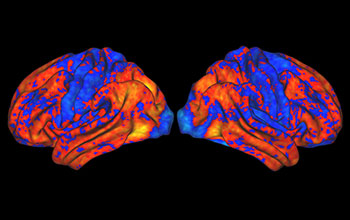Multimedia Gallery
NSF grant gives UVM's supercomputer a warp-speed upgrade
Research by University of Vermont psychiatry professor Hugh Garavan uses brain scans like the ones pictured here to determine the impact of drugs and alcohol on brain development in youth. The National Science Foundation-funded upgrade to the Vermont Advanced Computing Core will greatly facilitate this work.
More about this image
The National Science Foundation (NSF) has awarded the University of Vermont (UVM) a $1 million grant to significantly upgrade its Vermont Advanced Computing Core, or VACC.
The upgrade will include the addition of 72 high performance graphics processing units to the current VACC, which is housed in UVM's primary datacenter in South Burlington, to create a new high performance cluster.
Working together in a "massively parallel" system, the new cluster -- dubbed DeepGreen -- will be up to 3,000 times faster than the current VACC. At its peak, DeepGreen will be able to achieve a speed of over 1 petaflop, or one thousand million million computations per second, the equivalent of 20,000 laptop computers working in tandem. The massive upgrade will give UVM faculty access to one of the fastest supercomputers in New England and one of the 100 fastest academic supercomputers in the country.
The increase in processing speed, combined with a "big pipe," a hyper-fast connection the university will install from campus to the VACC, will enable faculty to take on new types of research projects they did not have the computational power to explore in the past, said Adrian Del Maestro, UVM associate professor of physics and the lead researcher on the NSF grant.
Read more about the new award in the UVM news story $1 Million NSF Grant to Give UVM's Supercomputer a Warp-Speed Upgrade. (Date image taken: Sept. 13, 2018; date originally posted to NSF Multimedia Gallery: May 17, 2019)
Credit: Philip Spechler, University of Vermont
Images and other media in the National Science Foundation Multimedia Gallery are available for use in print and electronic material by NSF employees, members of the media, university staff, teachers and the general public. All media in the gallery are intended for personal, educational and nonprofit/non-commercial use only.
Images credited to the National Science Foundation, a federal agency, are in the public domain. The images were created by employees of the United States Government as part of their official duties or prepared by contractors as "works for hire" for NSF. You may freely use NSF-credited images and, at your discretion, credit NSF with a "Courtesy: National Science Foundation" notation.
Additional information about general usage can be found in Conditions.
Also Available:
Download the high-resolution JPG version of the image. (506.9 KB)
Use your mouse to right-click (Mac users may need to Ctrl-click) the link above and choose the option that will save the file or target to your computer.

